Cost of safeguarding Polokwane’s rhinos raises eyebrows
The current contract for the safeguarding has expired and the municipality has invited tenders for the keeping of the rhinos for another three years.
February 12, 2022
Barry Viljoen
POLOKWANE – The fate of the rhinos owned by Polokwane Municipality that were relocated to a secret location near Bela-Bela towards the end of November 2018 is still undecided, although the local authority has spent close to R8m for the safeguarding of this endangered species on a private game farm for more than three years.
Initially, five animals were relocated, while four calves have joined the family after the relocation.
The current contract for the safeguarding has expired and the municipality has invited tenders for the keeping of the rhinos for another three years.
Although the bids closed on November 9, 2021, no decision about the matter has been taken as yet.
No visible attempts have been made to upgrade security at the local game reserve to allow for the animals to be returned to their home and be available for viewing by visitors, although it was stated by the municipality that the safekeeping was only a temporary arrangement.
A prominent game farmer in Limpopo, whose identity is protected, reckons the keeping of the rhinos is a waste of taxpayers’ money.
“The collective value of the dehorned animals is currently around R1.2m and to spend more than R8m on the safeguarding of the animals at a venue that is not even accessible to the city’s residents and visitors, is tantamount to fruitless and wasteful expenditure.
Spending money on this luxury, while residents don’t have basic services provided to them is totally out of kilter with the municipality’s core function,” he remarked.
Polokwane Municipality spokesperson Matshidiso Mothapo confirmed that the animals were moved to a sanctuary for security reasons since poaching increased in the years prior to the relocation.
“The reserve has in the past years suffered a protracted attack on and poaching of rhinos. As a result, council took a decision to relocate them temporarily while the process of upgrading security at the reserve is undertaken,” Mothapo explained and added that a proper supply chain process was followed.
According to Mothapo, the municipality is keeping the rhinos for a number of reasons.
“Polokwane Municipality owns a game reserve, which is a tourism attraction that offers a proper habitat for the rhinos. As other government entities, we also have a responsibility to conserve and protect endangered animal species for the benefit of the present and future generations. We all know that South Africa plays a critical role in the protection and conservation of the world’s remaining rhino population,” Mothapo explained.
Mothapo is confident that there is no waste of money.
“The municipality is not a private business with an intention of making money out of these animals, we are in the business of environmental conservation in this instance. The animals are not valued based on their financial worth, but on the role they play in the ecosystem and for their benefit of their conservation. Rhino conservation is an important issue as they also significantly affect the balance of the ecosystem and other animals in the game reserve,” Mothapo said, adding that rhinos are part of the Big 5 animals that are rare endangered animals on the verge of extinction.
“The current and future generations will be pleased to have them around and experience them in their natural habitat, and not only as documented or in pictures,” Mothapo highlighted.
Mothapo concluded, saying the finalisation of any bidding process rests on a validity period of 90 days.
“The municipality is embarking on a process of getting the right model of running the reserve at a more competent financial basis. This includes commercialisation model and private partnerships. The municipality has an open door policy and welcomes any developmental input in line with the spirit of Reaga Polokwane,” Mothapo assured.
It now remains to be seen whether the municipality is going to award a tender for the safekeeping of the rhinos for another three tears, without allowing visitors to view this species or to decide to dispose of this asset that has already cost the residents close to R8m over the last three years.
https://lowvelder.co.za/lnn/1164716/cos ... m00rbTLozw
Rhino Relocations
- Richprins
- Committee Member
- Posts: 76101
- Joined: Sat May 19, 2012 3:52 pm
- Location: NELSPRUIT
- Contact:
Re: Rhino Relocations
Please check Needs Attention pre-booking: https://africawild-forum.com/viewtopic.php?f=322&t=596
- Lisbeth
- Site Admin
- Posts: 67578
- Joined: Sat May 19, 2012 12:31 pm
- Country: Switzerland
- Location: Lugano
- Contact:
Re: Rhino Relocations
"the process of upgrading security at the reserve" would probably cost less. It is sooo easy to spend money that is not yours 
"Education is the most powerful weapon which you can use to change the world." Nelson Mandela
The desire for equality must never exceed the demands of knowledge
The desire for equality must never exceed the demands of knowledge
- Lisbeth
- Site Admin
- Posts: 67578
- Joined: Sat May 19, 2012 12:31 pm
- Country: Switzerland
- Location: Lugano
- Contact:
Re: Rhino Relocations
VISUAL ESSAY
SA rhino translocation lands Mozambican national park Big Five status
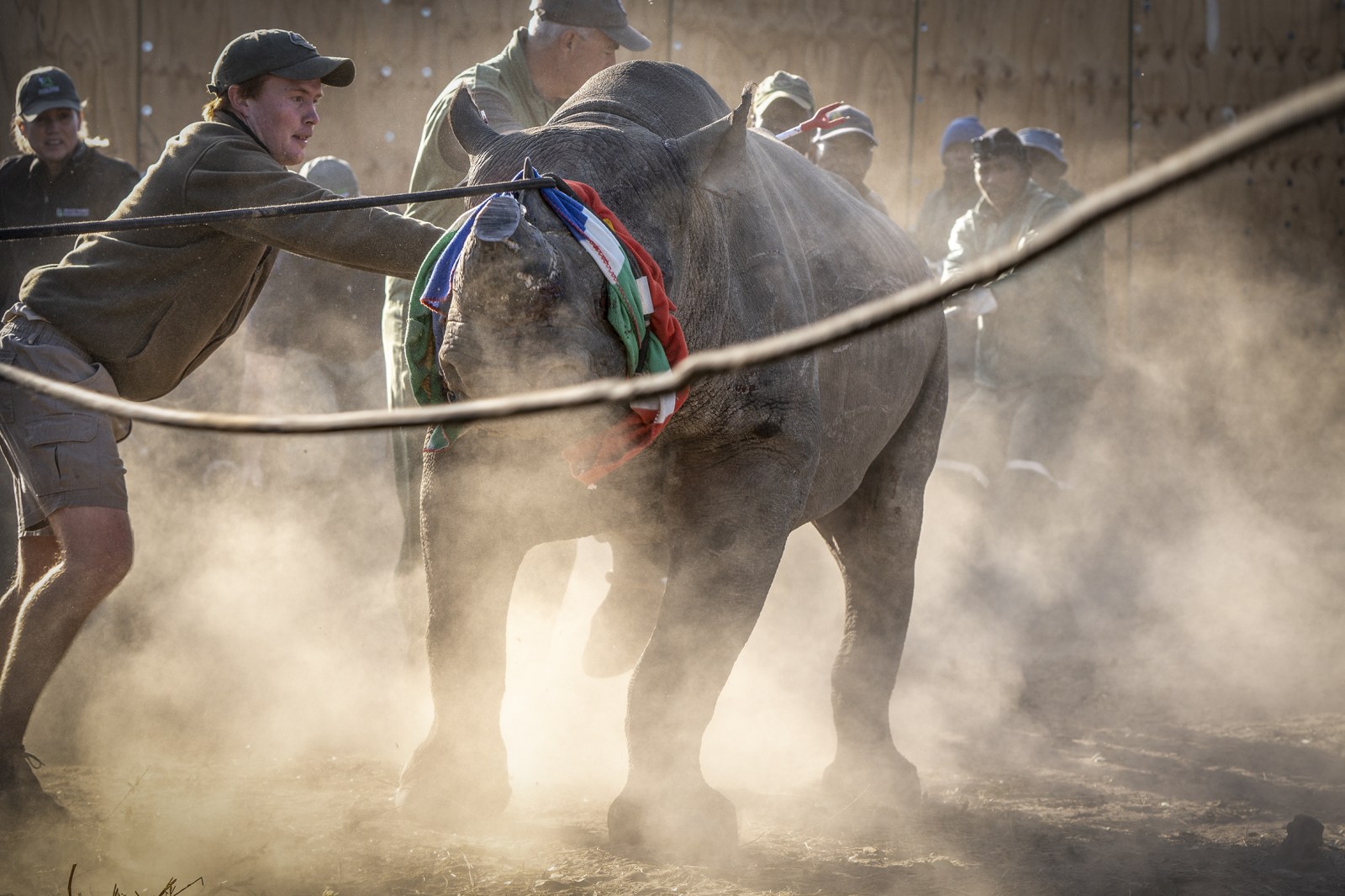
Conservationists prepare to move a black rhino into a transportation crate. The rhino translocation is also intended to increase tourism in Mozambique and help in the fight against rhino poaching in South Africa. (Photo: Shiraaz Mohamed)
By Shiraaz Mohamed | 31 Aug 2022
Click on the title!
SA rhino translocation lands Mozambican national park Big Five status

Conservationists prepare to move a black rhino into a transportation crate. The rhino translocation is also intended to increase tourism in Mozambique and help in the fight against rhino poaching in South Africa. (Photo: Shiraaz Mohamed)
By Shiraaz Mohamed | 31 Aug 2022
Click on the title!
"Education is the most powerful weapon which you can use to change the world." Nelson Mandela
The desire for equality must never exceed the demands of knowledge
The desire for equality must never exceed the demands of knowledge
- Richprins
- Committee Member
- Posts: 76101
- Joined: Sat May 19, 2012 3:52 pm
- Location: NELSPRUIT
- Contact:
Re: Rhino Relocations
Hope the poachers don't pop up there...
Please check Needs Attention pre-booking: https://africawild-forum.com/viewtopic.php?f=322&t=596
- Lisbeth
- Site Admin
- Posts: 67578
- Joined: Sat May 19, 2012 12:31 pm
- Country: Switzerland
- Location: Lugano
- Contact:
Re: Rhino Relocations
Orphaned black rhinos get a second shot at life after being moved to new home
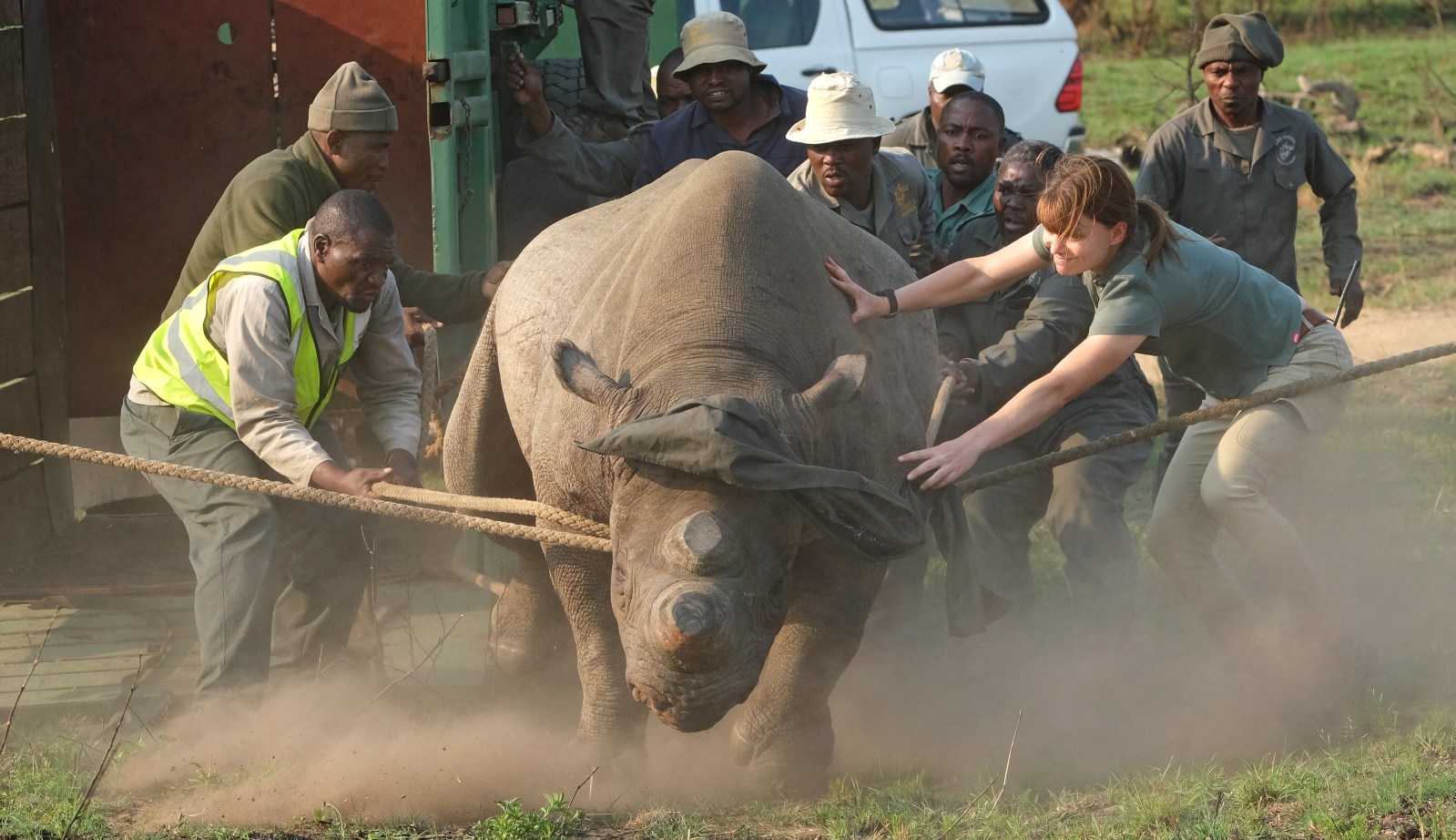
Members of the Ezemvelo KZN Wildlife game capture team and support staff battle to restrain an adult black rhino during its translocation to the Babanango Game Reserve. The capture team members include (from left to right) Musa Nkosi, Xolani Zwane, Philemon Ndwandwe, Sakhile Myeni, Zakhe Mahlaba, Zamokuhle Gumede, Bongani Zondi, Thulani Nkosi and Ursina Rusch from the WWF Black Rhino Range Expansion Project. (Photo: Seyms Brugger)
By Tony Carnie | 19 Oct 2022
The move is part of a project that began two decades ago to expand the numbers and range of this critically endangered rhino species that has all but disappeared from large areas of Africa due to horn poaching.
__________________________________________________________________________________________________________________
A small group of black rhinos — including four orphans whose mothers were butchered by horn poachers — are back in the wild after being shifted to a new home in KwaZulu-Natal.
The move is part of a project that began two decades ago to expand the numbers and range of this critically endangered rhino species that has all but disappeared from large areas of Africa due to horn poaching.
Amid this relentless killing spree, at least four survivors now have a second shot to recover and boost their species’ depleted numbers.
Jeff Cooke, the head of game capture at the Ezemvelo KZN Wildlife conservation agency, said: “The symbolism of this event cannot be overstated. The successful release of these four black rhinos that, under any other circumstance would have been lost to the species, is a strong testament to the determination and commitment of the staff at the Ezemvelo game capture facility in Hluhluwe-iMfolozi Park.
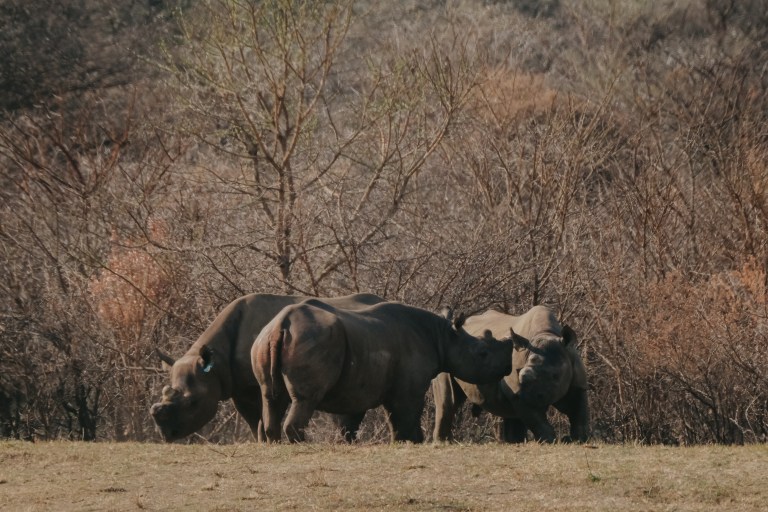
Three of the orphans explore their new home. (Photo: Seyms Brugger)
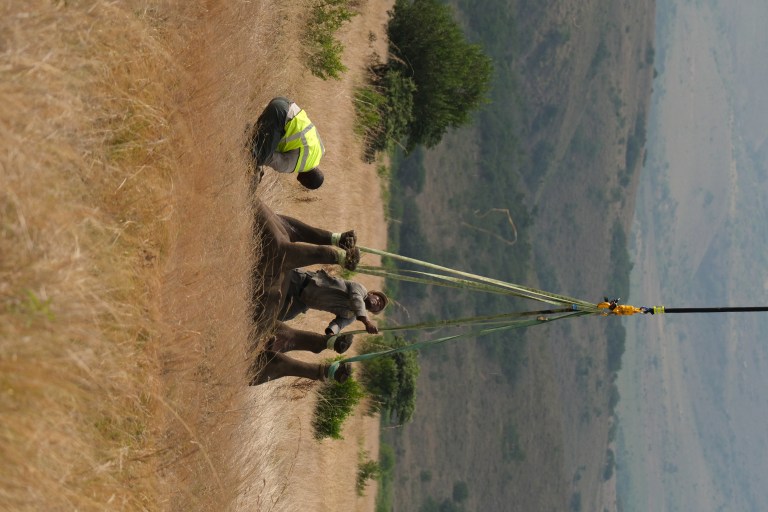
Due to rugged terrain some of the relocated rhinos had to be airlifted by helicopter to a nearby loading spot. (Photo: Seyms Brugger)
Schoolchildren donors
“They spent thousands of hours caring for them and there are also many donors and funders, some of them just schoolchildren, who gave willingly to ensure that these animals were given a chance. The message is clear: we need to remain committed and united as a province to the task of saving this iconic species, even if it is one animal at a time,” said Cooke.
The four animals, which were orphaned between the ages of two months and one year, were rescued and placed into the boma facilities in Hluhluwe-iMfolozi Park and received 24-hour care and feeding from a team led by Dumi Zwane, the officer in charge of game capture field operations.
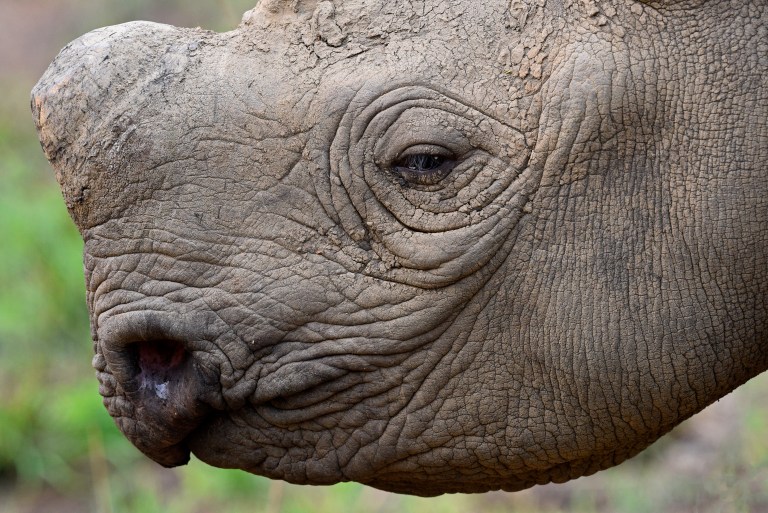
One of the orphaned black rhinos was dehorned as a safety measure. (Photo: Seyms Brugger)
Now strapping sub-adults aged between five and six years, the orphans were released earlier this month into the community-owned Babanango Game Reserve, along with a small group of older black rhinos relocated from other reserves as part of the WWF/Ezemvelo Black Rhino Range Expansion Project.
Black rhino populations suffered a drastic decline at the end of the 20th century. Between 1970 and 1993, the population decreased by 96% from about 65,000 to only 2,300 surviving in the wild.
But things are changing.
Population growth
Since 1996, intense anti-poaching efforts and strategic translocations to safer areas have allowed the species to slowly recover and the African Rhino Specialist Group estimates that there has been a 12% growth in black rhino populations in recent years — from 5,495 individuals in 2017 to more than 6,195 today.
Sadly, the numbers of the more populous southern white rhino species continue to drop sharply, in South Africa and other parts of the continent.
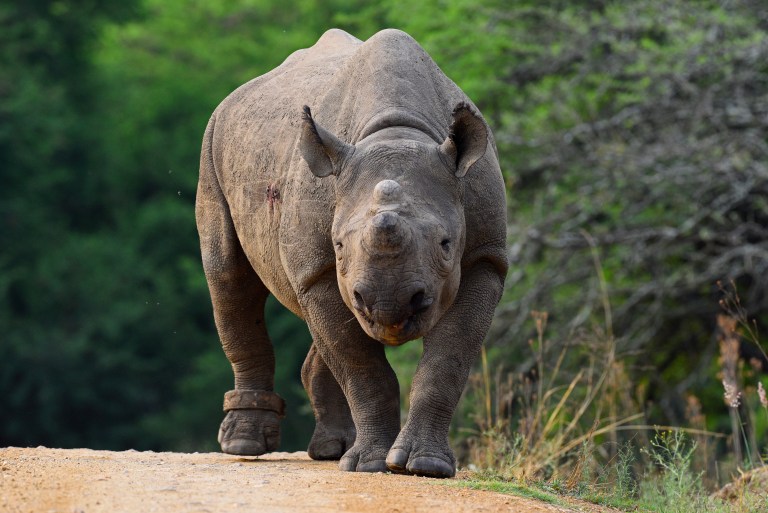
Each rhino has a tracking device fitted on a leg. (Photo: Seyms Brugger)
The latest assessment by the International Rhino Foundation says this population has decreased by almost 12% in the past four years, from an estimated 18,067 to fewer than 16,000 today.
In Kruger National Park, once home to the largest rhino population in the world, overall rhino numbers have crashed by between 66% and 70% over the past decade. This is why finding new and more secure living spaces for both rhino species has become critical.
Last week, in partnership with the WWF Black Rhino Range Expansion Project, Wildlife ACT and Conservation Outcomes, the new founder group of black rhinos was loaded into crates and trucked to the 20,000-hectare Babanango Game Reserve.
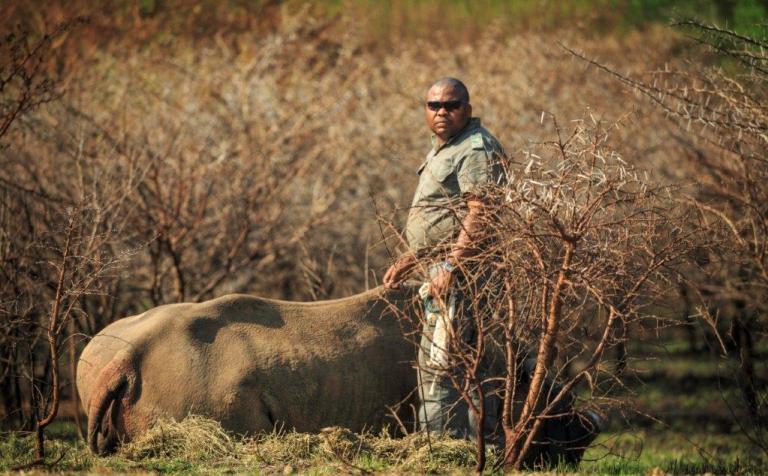
The translocation of the orphans was an emotional moment for Dumisani Zwane, officer in charge of Ezemvelo KZN Wildlife game capture field operations. (Photo: Chris Galliers)
More than 75% of the land in the Babanango reserve is owned by members of the surrounding Emcakwini, KwaNgono and Esibongweni community trusts.
To bolster their protection, each rhino has been fitted with a tracking device to ensure effective post-release monitoring.
“We are extremely grateful to committed partners in devoting their land, money and resources to black rhino conservation. It is wonderful that these orphans were rescued by Ezemvelo and now have a chance to become part of a new wild population,” said the range expansion project leader, Dr Jacques Flamand. DM/OBP

Members of the Ezemvelo KZN Wildlife game capture team and support staff battle to restrain an adult black rhino during its translocation to the Babanango Game Reserve. The capture team members include (from left to right) Musa Nkosi, Xolani Zwane, Philemon Ndwandwe, Sakhile Myeni, Zakhe Mahlaba, Zamokuhle Gumede, Bongani Zondi, Thulani Nkosi and Ursina Rusch from the WWF Black Rhino Range Expansion Project. (Photo: Seyms Brugger)
By Tony Carnie | 19 Oct 2022
The move is part of a project that began two decades ago to expand the numbers and range of this critically endangered rhino species that has all but disappeared from large areas of Africa due to horn poaching.
__________________________________________________________________________________________________________________
A small group of black rhinos — including four orphans whose mothers were butchered by horn poachers — are back in the wild after being shifted to a new home in KwaZulu-Natal.
The move is part of a project that began two decades ago to expand the numbers and range of this critically endangered rhino species that has all but disappeared from large areas of Africa due to horn poaching.
Amid this relentless killing spree, at least four survivors now have a second shot to recover and boost their species’ depleted numbers.
Jeff Cooke, the head of game capture at the Ezemvelo KZN Wildlife conservation agency, said: “The symbolism of this event cannot be overstated. The successful release of these four black rhinos that, under any other circumstance would have been lost to the species, is a strong testament to the determination and commitment of the staff at the Ezemvelo game capture facility in Hluhluwe-iMfolozi Park.

Three of the orphans explore their new home. (Photo: Seyms Brugger)

Due to rugged terrain some of the relocated rhinos had to be airlifted by helicopter to a nearby loading spot. (Photo: Seyms Brugger)
Schoolchildren donors
“They spent thousands of hours caring for them and there are also many donors and funders, some of them just schoolchildren, who gave willingly to ensure that these animals were given a chance. The message is clear: we need to remain committed and united as a province to the task of saving this iconic species, even if it is one animal at a time,” said Cooke.
The four animals, which were orphaned between the ages of two months and one year, were rescued and placed into the boma facilities in Hluhluwe-iMfolozi Park and received 24-hour care and feeding from a team led by Dumi Zwane, the officer in charge of game capture field operations.

One of the orphaned black rhinos was dehorned as a safety measure. (Photo: Seyms Brugger)
Now strapping sub-adults aged between five and six years, the orphans were released earlier this month into the community-owned Babanango Game Reserve, along with a small group of older black rhinos relocated from other reserves as part of the WWF/Ezemvelo Black Rhino Range Expansion Project.
Black rhino populations suffered a drastic decline at the end of the 20th century. Between 1970 and 1993, the population decreased by 96% from about 65,000 to only 2,300 surviving in the wild.
But things are changing.
Population growth
Since 1996, intense anti-poaching efforts and strategic translocations to safer areas have allowed the species to slowly recover and the African Rhino Specialist Group estimates that there has been a 12% growth in black rhino populations in recent years — from 5,495 individuals in 2017 to more than 6,195 today.
Sadly, the numbers of the more populous southern white rhino species continue to drop sharply, in South Africa and other parts of the continent.
Each rhino has a tracking device fitted on a leg. (Photo: Seyms Brugger)
The latest assessment by the International Rhino Foundation says this population has decreased by almost 12% in the past four years, from an estimated 18,067 to fewer than 16,000 today.
In Kruger National Park, once home to the largest rhino population in the world, overall rhino numbers have crashed by between 66% and 70% over the past decade. This is why finding new and more secure living spaces for both rhino species has become critical.
Last week, in partnership with the WWF Black Rhino Range Expansion Project, Wildlife ACT and Conservation Outcomes, the new founder group of black rhinos was loaded into crates and trucked to the 20,000-hectare Babanango Game Reserve.

The translocation of the orphans was an emotional moment for Dumisani Zwane, officer in charge of Ezemvelo KZN Wildlife game capture field operations. (Photo: Chris Galliers)
More than 75% of the land in the Babanango reserve is owned by members of the surrounding Emcakwini, KwaNgono and Esibongweni community trusts.
To bolster their protection, each rhino has been fitted with a tracking device to ensure effective post-release monitoring.
“We are extremely grateful to committed partners in devoting their land, money and resources to black rhino conservation. It is wonderful that these orphans were rescued by Ezemvelo and now have a chance to become part of a new wild population,” said the range expansion project leader, Dr Jacques Flamand. DM/OBP
"Education is the most powerful weapon which you can use to change the world." Nelson Mandela
The desire for equality must never exceed the demands of knowledge
The desire for equality must never exceed the demands of knowledge
- Richprins
- Committee Member
- Posts: 76101
- Joined: Sat May 19, 2012 3:52 pm
- Location: NELSPRUIT
- Contact:
Re: Rhino Relocations
That first pic is brilliant!
Please check Needs Attention pre-booking: https://africawild-forum.com/viewtopic.php?f=322&t=596
- Lisbeth
- Site Admin
- Posts: 67578
- Joined: Sat May 19, 2012 12:31 pm
- Country: Switzerland
- Location: Lugano
- Contact:
Re: Rhino Relocations
Watch:
AG (Africa Geographic) project partner Wildlife ACT recently worked with WWF South Africa, Ezemvelo KZN Wildlife and others to translocate four orphaned black rhinos into their new home at Babanango Game Reserve. Check out this unique footage of the intricate work involved in translocating and protecting rhinos
We are proud to share the full story of our recently released Black Rhino on to Babanango Game Reserve.
"This occasion marks an important and significant step in the reintroduction of both endangered and threatened wildlife species onto our land. May they roam safely and freely again, for the benefit of conservation, and the wise education of our children for generations to come” Emcakwini Community Trust - Babanango Game Reserve.
AG (Africa Geographic) project partner Wildlife ACT recently worked with WWF South Africa, Ezemvelo KZN Wildlife and others to translocate four orphaned black rhinos into their new home at Babanango Game Reserve. Check out this unique footage of the intricate work involved in translocating and protecting rhinos
We are proud to share the full story of our recently released Black Rhino on to Babanango Game Reserve.
"This occasion marks an important and significant step in the reintroduction of both endangered and threatened wildlife species onto our land. May they roam safely and freely again, for the benefit of conservation, and the wise education of our children for generations to come” Emcakwini Community Trust - Babanango Game Reserve.
"Education is the most powerful weapon which you can use to change the world." Nelson Mandela
The desire for equality must never exceed the demands of knowledge
The desire for equality must never exceed the demands of knowledge
- Lisbeth
- Site Admin
- Posts: 67578
- Joined: Sat May 19, 2012 12:31 pm
- Country: Switzerland
- Location: Lugano
- Contact:
Re: Rhino Relocations
An Interview: The complicated business of flying rhinos
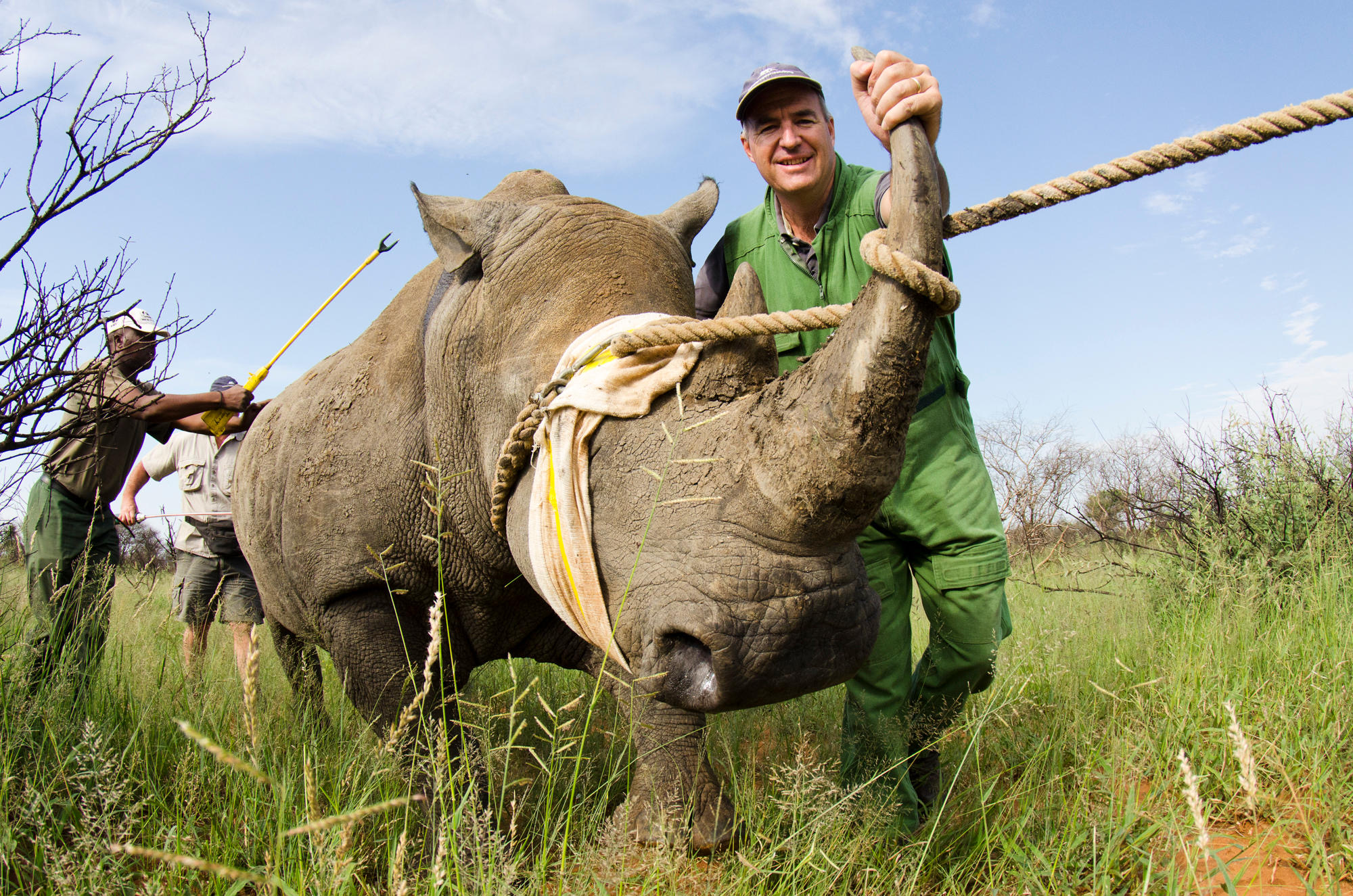
A rhino is accompanied by Kester Vickery to the crates in Phinda Game Reserve, South Africa. (Photo: Frank Weitzer)
By Don Pinnock | 13 Jun 2023
Conservationist Kester Vickery has just translocated 16 rhinos into Garamba National Park, deep in the wildlands of Democratic Republic of the Congo.
_________________________________________________________________________________________________________________________
As airline passengers go, rhinos are not the easiest customers. They don’t queue, show their passports then quietly wait to board. They snort, stomp and lash out with dangerous weapons.
But Kester Vickery knows the drill. He’s worked in 18 countries transporting thousands of wild animals of around 14 species. Under his care, 16 wild-caught rhinos from Phinda Private Game Reserve in KZN touched down at a remote airstrip in Democratic Republic of the Congo (DRC) last week and entered Garamba National Park into the care of its African Parks team.
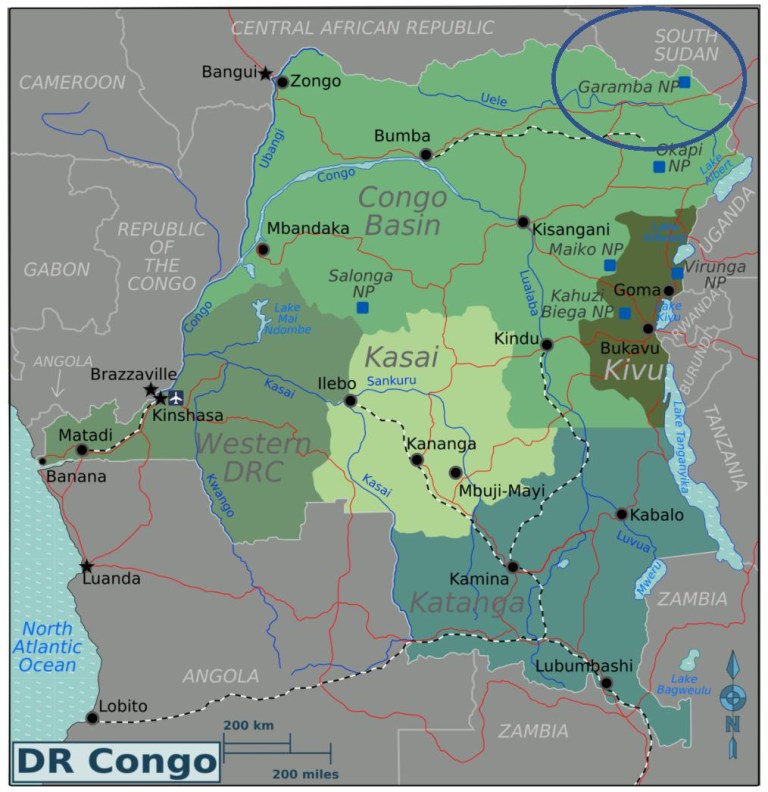
A map location of Garamba. (Image: Supplied)
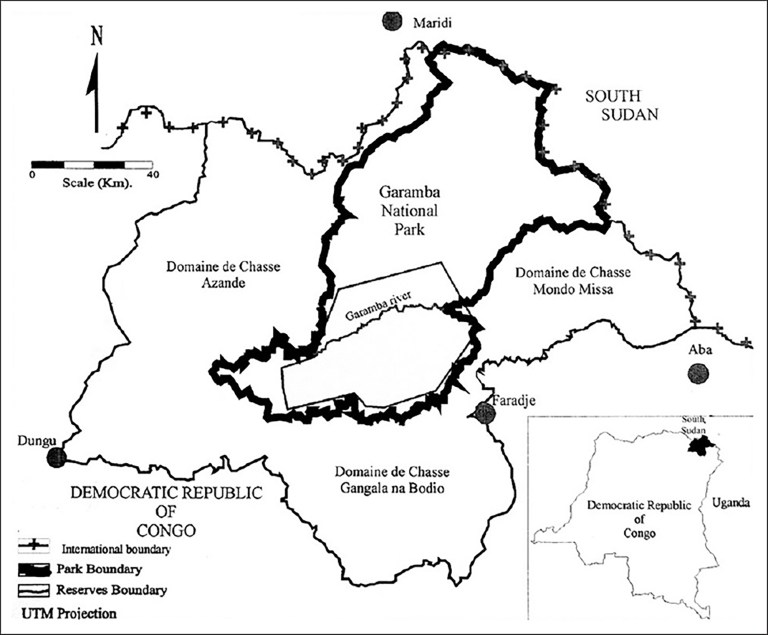
A map of Garamba. (Image: Supplied)
Kester’s passion is rewilding Africa, he says, not transporting animals into confinement, as in zoos. He’s been doing it for most of his working life. Starting as a young game ranger, his company Conservation Solutions is today the biggest wildlife relocator outfit on the continent. In fact, he’s something of a legend.
His work over the past 25 years includes the restocking of entire protected areas, the reintroduction of endangered species such as black rhino, lion, oribi, eland and cheetah into countries where they had previously gone extinct, the movement of more than 3,000 elephants and 4,000 white rhinos, and the largest and most complex elephant translocations ever undertaken.
Daily Maverick asked him to explain the nuts and bolts of capturing and moving a bad-tempered, sharp-horned animal the weight of a motor car.
“At Phinda, we made a selection from a helicopter: not too young or old and in good condition. Then we darted them with M99. It’s extremely toxic to humans – if you prick your finger on the dart tip, within a few minutes you die. It’s about 10,000 times stronger than normal-grade morphine. But all it does to a rhino is put it to sleep.
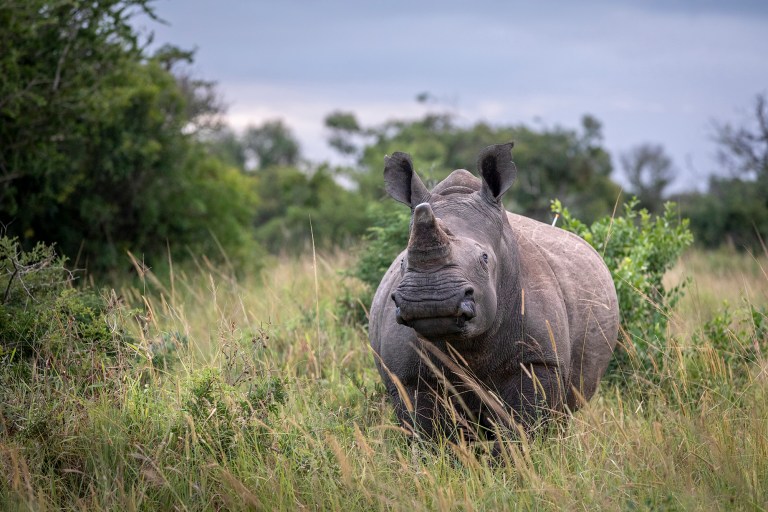
A white rhino in Phinda Private Game Reserve, South Africa. (Photo: Mike Dexter)
“Then you have to get the ground team to the rhino fast. If you observe its blood and is dark, it means it’s not getting enough oxygen. We’ll then use M5050 as a reversal to get its breathing back up.
“We then tie ropes front and back, blindfold it and partially wake it up. In that state, a team of four can walk it to a waiting truck and into a travel crate. If it wakes up and starts throwing the crate around – and it can – we give it a smidgen more M99 and tranquillisers to calm it down and we hope that’s all it will need for the trip.”
It all sounds pretty routine. Have there been mishaps?
“Oh yeah! The really dangerous part is taking off the rope and blindfold. They’re head first in the crate so you have to get there, generally over their back. If they jump you get rammed against the top of the crate.
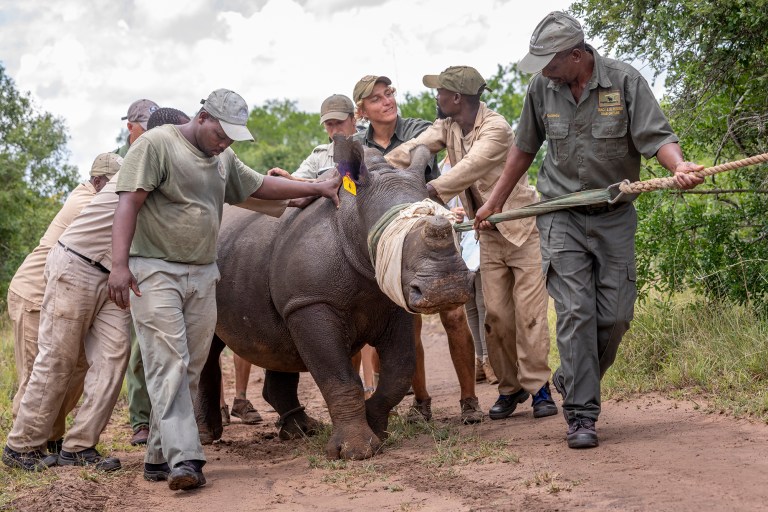
Experts gently walk a tranquillised rhino to a crate. (Photo: Mike Dexter)
“If it wakes up too much before crating, it will go for us and send us up trees… very dangerous, especially if it’s a black rhino. They have attitude, they’re fighters and don’t like humans.”
The biggest part of translocation, though, is the preparation – and it can take years. An independent security assessment has to be done at the destination to ensure, as much as possible, the safety of the animals. Then, if it’s a trans-border operation, permits are required from the source and destination countries, plus CITES international permits, DNA samples have to be provided to the Onderstepoort veterinary facility and all the animals have to be microchipped.
“Then you have to capture the animals and provide DNA samples to the Onderstepoort veterinary facility, which is a waste of time really because they don’t analyse them, they just store them. And you have to microchip the horns, which is also mostly a waste of time because the rhinos rub their horns all the time and kill the chip.”
How can you be sure that, after all that trouble, the rhinos aren’t going to be poached in Garamba?
“You can never 100% know what’s going to happen five or 10 years from now, but African Parks is a really responsible organisation and they wouldn’t introduce them if they weren’t confident about protecting them.
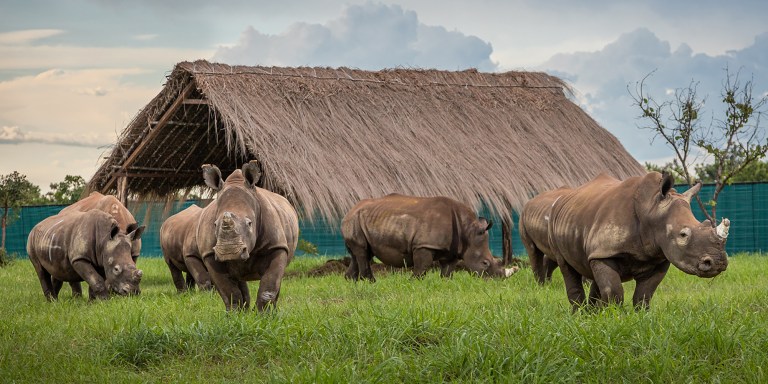
White rhinos at Garamba National Park in Democratic Republic of the Congo. (Photo: Martin van Rooyen)
“Actually, it’s an extraordinary organisation. Speaking under correction, there must be at least 300 scouts at Garamba. There’s been an independent security assessment done… I’ve been there and it looks good.
“Elephants in the area were hugely shot out, reduced from tens of thousands to approximately two thousand. But since African Parks took over there’s been very little poaching in the last 5 years. African Parks can do this. They’re well-resourced and highly ethical and I’m certain those rhinos will be protected.”
Which are the most difficult animals to move?
The hardest animal to move is the one you’re working with that day.
There’s a broad set of rules and experience, but at the end of the day, you’re dealing with wild animals that are unpredictable. Rhinos are actually a bit easier. You’re working with one rhino, one crate, you have more control.
“Elephants are more tricky because you’re working with many at once. There’ll be a container with 10 to 12 elephants. Each animal has different complexities.
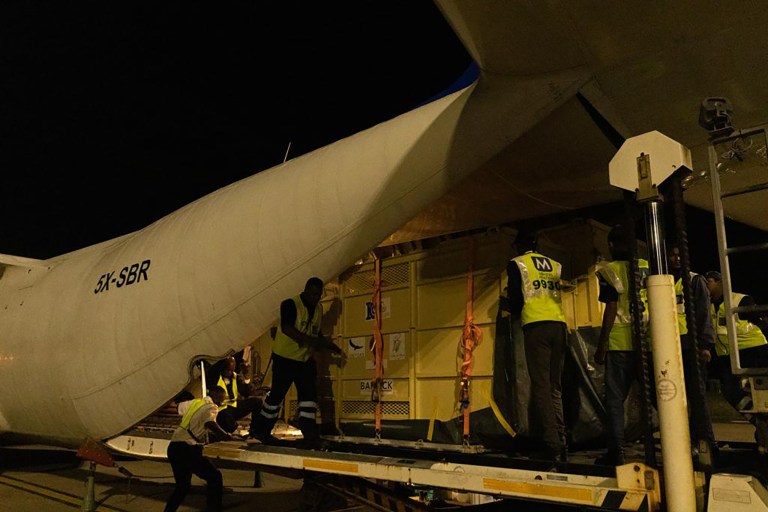
Rhino crates being loaded on to a plane at Durban’s King Shaka International Airport, South Africa. (Photo: Frank Weitzer)
“We’ve moved more than 1,000 elephants for African Parks. In a single day, we moved 38. We’ve developed very sophisticated equipment tailor-made for the job. In one month we moved more than 2,000 animals, of which around 264 were elephants. Lots of logistics, lots of organising.
“We have a fleet of trucks – we prefer using trucks and only use air if we have to, like with the Garamba rhinos. There the terrain is logistically challenging but thankfully there is an airstrip at Kibali mine.
“Our trucks have interchangeable modules for different animals. If you go to Kruger National Park and ask how they move animals, they’ll show you a truck that moves antelope, another truck that can move rhinos, some equipment built in the 1990s. All are out of date. Because we’re a commercial enterprise, we need to be super efficient. We find solutions.
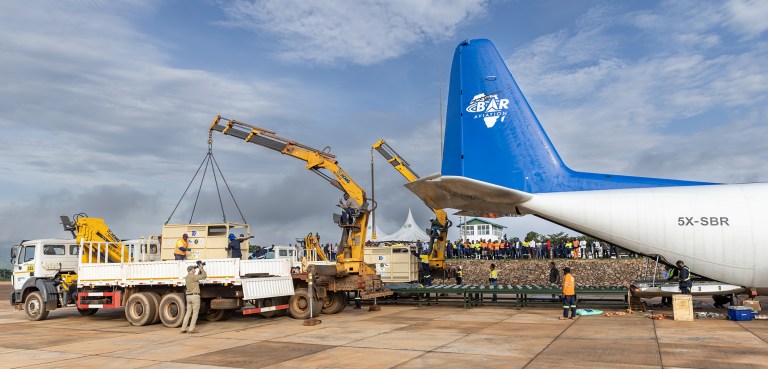
The arrival of the plane with rhinos at Doko Airport, Democratic Republic of the Congo. (Photo: Frank Weitzer)
“Five or 10 years ago the things we do now wouldn’t have been possible. We’re getting better at it. It has opened massive possibilities to be able to rewild new areas further away. The longer we do this, the more possibilities there are to rewild areas where these species no longer exist, or only in small numbers. It’s actually quite an exciting time in our industry.
“But you must understand, it doesn’t always go according to plan. There are risks, but 99% of what we do works out. We have had animals die under anaesthetic – very few – but it’s always heartbreaking.
“We’ve all had close shaves; elephants getting out of crates, lions waking up on the plane and trying to trash their cages, people being chased around by rhinos. Nobody’s written the book about how it should be done.”
Lions trying to get out of crates on a plane?
“Yeah, it was an African Parks project. Terrifying. They were going to Rwanda. They were loaded into a Ukrainian cargo plane at OR Tambo – I think it was an Antonov we hired. A colleague and I were in the hold with the crated lions. They were tranquillised but started waking up and bashing the cages, which were made from angle iron. There was a point when they were bending the doors and were going to pop out.
“I went forward to explain to the pilot that there was impending doom back there and we needed to land somewhere. Like in the movies, the captain was flying in a white vest, all very chilled, smoking heavily. But he didn’t speak English. So I started gesticulating frantically, showing they were going to eat us. He got up and said, ‘No, no you fix’, and literally booted me out of the cockpit and shut the door.”
Good grief, what happened?
We couldn’t tranquilize them given the way the crates are constructed. So we positioned the crate doors against the fuselage after finding some chains to bind the doors shut. Eventually, the lions calmed down. Maybe it was from the volumes of cigarette smoke coming out of the cockpit. We landed okay.
“Nothing like that happened with Garamba’s rhinos, fortunately. The rhinos were airlifted in two moves from King Shaka International Airport to Barrick’s Kibali Mine airstrip in north eastern DRC and then trucked to Garamba National Park. Each move took approximately 30 hours and by the 10th of June, 2023, the 16 white rhinos were being released into a holding paddock in Garamba.”
African Parks’ CEO, Peter Fearnhead was both relieved and delighted.
“Efforts to save the northern white rhino was a case of ‘too little too late’ and should never be allowed to happen again,” he said.
“Now that Garamba is a safe location and has proper protection in place, this reintroduction is the start of a process whereby southern white rhino, as the closest genetic alternative, can fulfil the role of the northern white rhino in the landscape.”
More rhinos will be translocated to Garamba National Park over the next few years to create a viable breeding population. When that happens, African Parks will know who to call. DM

A rhino is accompanied by Kester Vickery to the crates in Phinda Game Reserve, South Africa. (Photo: Frank Weitzer)
By Don Pinnock | 13 Jun 2023
Conservationist Kester Vickery has just translocated 16 rhinos into Garamba National Park, deep in the wildlands of Democratic Republic of the Congo.
_________________________________________________________________________________________________________________________
As airline passengers go, rhinos are not the easiest customers. They don’t queue, show their passports then quietly wait to board. They snort, stomp and lash out with dangerous weapons.
But Kester Vickery knows the drill. He’s worked in 18 countries transporting thousands of wild animals of around 14 species. Under his care, 16 wild-caught rhinos from Phinda Private Game Reserve in KZN touched down at a remote airstrip in Democratic Republic of the Congo (DRC) last week and entered Garamba National Park into the care of its African Parks team.

A map location of Garamba. (Image: Supplied)

A map of Garamba. (Image: Supplied)
Kester’s passion is rewilding Africa, he says, not transporting animals into confinement, as in zoos. He’s been doing it for most of his working life. Starting as a young game ranger, his company Conservation Solutions is today the biggest wildlife relocator outfit on the continent. In fact, he’s something of a legend.
His work over the past 25 years includes the restocking of entire protected areas, the reintroduction of endangered species such as black rhino, lion, oribi, eland and cheetah into countries where they had previously gone extinct, the movement of more than 3,000 elephants and 4,000 white rhinos, and the largest and most complex elephant translocations ever undertaken.
Daily Maverick asked him to explain the nuts and bolts of capturing and moving a bad-tempered, sharp-horned animal the weight of a motor car.
“At Phinda, we made a selection from a helicopter: not too young or old and in good condition. Then we darted them with M99. It’s extremely toxic to humans – if you prick your finger on the dart tip, within a few minutes you die. It’s about 10,000 times stronger than normal-grade morphine. But all it does to a rhino is put it to sleep.

A white rhino in Phinda Private Game Reserve, South Africa. (Photo: Mike Dexter)
“Then you have to get the ground team to the rhino fast. If you observe its blood and is dark, it means it’s not getting enough oxygen. We’ll then use M5050 as a reversal to get its breathing back up.
“We then tie ropes front and back, blindfold it and partially wake it up. In that state, a team of four can walk it to a waiting truck and into a travel crate. If it wakes up and starts throwing the crate around – and it can – we give it a smidgen more M99 and tranquillisers to calm it down and we hope that’s all it will need for the trip.”
It all sounds pretty routine. Have there been mishaps?
“Oh yeah! The really dangerous part is taking off the rope and blindfold. They’re head first in the crate so you have to get there, generally over their back. If they jump you get rammed against the top of the crate.

Experts gently walk a tranquillised rhino to a crate. (Photo: Mike Dexter)
“If it wakes up too much before crating, it will go for us and send us up trees… very dangerous, especially if it’s a black rhino. They have attitude, they’re fighters and don’t like humans.”
The biggest part of translocation, though, is the preparation – and it can take years. An independent security assessment has to be done at the destination to ensure, as much as possible, the safety of the animals. Then, if it’s a trans-border operation, permits are required from the source and destination countries, plus CITES international permits, DNA samples have to be provided to the Onderstepoort veterinary facility and all the animals have to be microchipped.
“Then you have to capture the animals and provide DNA samples to the Onderstepoort veterinary facility, which is a waste of time really because they don’t analyse them, they just store them. And you have to microchip the horns, which is also mostly a waste of time because the rhinos rub their horns all the time and kill the chip.”
How can you be sure that, after all that trouble, the rhinos aren’t going to be poached in Garamba?
“You can never 100% know what’s going to happen five or 10 years from now, but African Parks is a really responsible organisation and they wouldn’t introduce them if they weren’t confident about protecting them.

White rhinos at Garamba National Park in Democratic Republic of the Congo. (Photo: Martin van Rooyen)
“Actually, it’s an extraordinary organisation. Speaking under correction, there must be at least 300 scouts at Garamba. There’s been an independent security assessment done… I’ve been there and it looks good.
“Elephants in the area were hugely shot out, reduced from tens of thousands to approximately two thousand. But since African Parks took over there’s been very little poaching in the last 5 years. African Parks can do this. They’re well-resourced and highly ethical and I’m certain those rhinos will be protected.”
Which are the most difficult animals to move?
The hardest animal to move is the one you’re working with that day.
There’s a broad set of rules and experience, but at the end of the day, you’re dealing with wild animals that are unpredictable. Rhinos are actually a bit easier. You’re working with one rhino, one crate, you have more control.
“Elephants are more tricky because you’re working with many at once. There’ll be a container with 10 to 12 elephants. Each animal has different complexities.

Rhino crates being loaded on to a plane at Durban’s King Shaka International Airport, South Africa. (Photo: Frank Weitzer)
“We’ve moved more than 1,000 elephants for African Parks. In a single day, we moved 38. We’ve developed very sophisticated equipment tailor-made for the job. In one month we moved more than 2,000 animals, of which around 264 were elephants. Lots of logistics, lots of organising.
“We have a fleet of trucks – we prefer using trucks and only use air if we have to, like with the Garamba rhinos. There the terrain is logistically challenging but thankfully there is an airstrip at Kibali mine.
“Our trucks have interchangeable modules for different animals. If you go to Kruger National Park and ask how they move animals, they’ll show you a truck that moves antelope, another truck that can move rhinos, some equipment built in the 1990s. All are out of date. Because we’re a commercial enterprise, we need to be super efficient. We find solutions.

The arrival of the plane with rhinos at Doko Airport, Democratic Republic of the Congo. (Photo: Frank Weitzer)
“Five or 10 years ago the things we do now wouldn’t have been possible. We’re getting better at it. It has opened massive possibilities to be able to rewild new areas further away. The longer we do this, the more possibilities there are to rewild areas where these species no longer exist, or only in small numbers. It’s actually quite an exciting time in our industry.
“But you must understand, it doesn’t always go according to plan. There are risks, but 99% of what we do works out. We have had animals die under anaesthetic – very few – but it’s always heartbreaking.
“We’ve all had close shaves; elephants getting out of crates, lions waking up on the plane and trying to trash their cages, people being chased around by rhinos. Nobody’s written the book about how it should be done.”
Lions trying to get out of crates on a plane?
“Yeah, it was an African Parks project. Terrifying. They were going to Rwanda. They were loaded into a Ukrainian cargo plane at OR Tambo – I think it was an Antonov we hired. A colleague and I were in the hold with the crated lions. They were tranquillised but started waking up and bashing the cages, which were made from angle iron. There was a point when they were bending the doors and were going to pop out.
“I went forward to explain to the pilot that there was impending doom back there and we needed to land somewhere. Like in the movies, the captain was flying in a white vest, all very chilled, smoking heavily. But he didn’t speak English. So I started gesticulating frantically, showing they were going to eat us. He got up and said, ‘No, no you fix’, and literally booted me out of the cockpit and shut the door.”
Good grief, what happened?
We couldn’t tranquilize them given the way the crates are constructed. So we positioned the crate doors against the fuselage after finding some chains to bind the doors shut. Eventually, the lions calmed down. Maybe it was from the volumes of cigarette smoke coming out of the cockpit. We landed okay.
“Nothing like that happened with Garamba’s rhinos, fortunately. The rhinos were airlifted in two moves from King Shaka International Airport to Barrick’s Kibali Mine airstrip in north eastern DRC and then trucked to Garamba National Park. Each move took approximately 30 hours and by the 10th of June, 2023, the 16 white rhinos were being released into a holding paddock in Garamba.”
African Parks’ CEO, Peter Fearnhead was both relieved and delighted.
“Efforts to save the northern white rhino was a case of ‘too little too late’ and should never be allowed to happen again,” he said.
“Now that Garamba is a safe location and has proper protection in place, this reintroduction is the start of a process whereby southern white rhino, as the closest genetic alternative, can fulfil the role of the northern white rhino in the landscape.”
More rhinos will be translocated to Garamba National Park over the next few years to create a viable breeding population. When that happens, African Parks will know who to call. DM
"Education is the most powerful weapon which you can use to change the world." Nelson Mandela
The desire for equality must never exceed the demands of knowledge
The desire for equality must never exceed the demands of knowledge
- Peter Betts
- Posts: 3084
- Joined: Fri Jun 01, 2012 9:28 am
- Country: RSA
- Contact:
- Lisbeth
- Site Admin
- Posts: 67578
- Joined: Sat May 19, 2012 12:31 pm
- Country: Switzerland
- Location: Lugano
- Contact:
Re: Rhino Relocations
Don't be so negative, African Parks by now must have a lot of experience  I am sure that they have not gone through this enormous operation without knowing exactly what they are doing.
I am sure that they have not gone through this enormous operation without knowing exactly what they are doing.
"Education is the most powerful weapon which you can use to change the world." Nelson Mandela
The desire for equality must never exceed the demands of knowledge
The desire for equality must never exceed the demands of knowledge


